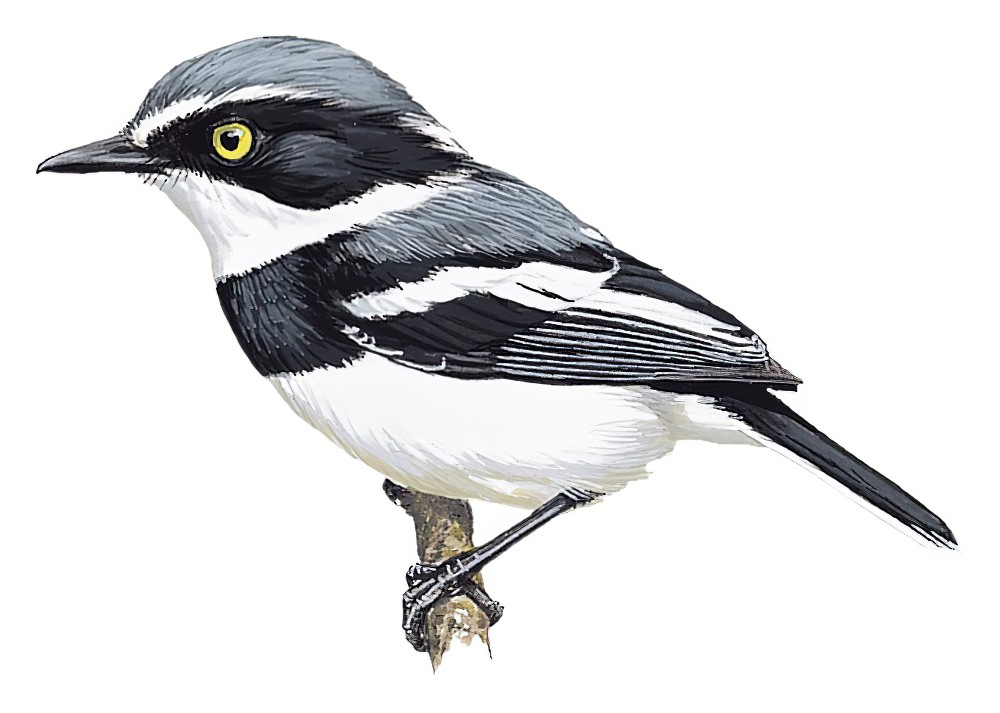Pale Batis / Batis soror

Pale Batis
SCI Name:
Protonym: Batis puella soror Vog.Afr. 2 pt2 p.485
Taxonomy: Passeriformes / Platysteiridae / Batis
Taxonomy Code: palbat1
Type Locality: Zanzibar and Nyasa region to Quelimane, Mozambique; restricted to Songea, southern Tanganyika, by Neumann, 1907, Journ. Ornith., 55, p. 357.
Author: Reichenow
Publish Year: 1903
IUCN Status: Least Concern
DEFINITIONS
BATIS
(Platysteiridae; Ϯ Cape Batis B. capensis) Gr. βατις batis, βατιδος batidos grub- or worm-eating bird mentioned by Aristotle, not further identified, but later associated with a variety of buntings, warblers and chats, including the Western Stonechat (e.g. Turner 1544); "Fam. Muscicapidae. Vigors. Sippe Batis. Char. essentialis. 1) Gefieder weiß und schwarz bey ♂, bey ♀ rostfarben und weiß. 2) Länge 5—8 Zoll. 3) Die obere Kinnlade an der Spitze über die untere gekrümmt. 4) 3te Schwungfeder die längste. 5) Die fast ganz von Federn bedeckten Nasenlöcher auf der obern Fläche des Schnabels. Arten. Africa: 1) Muscicapa strepitans Lichtenstein, Museum Berlin. 2) — melanoleuca Licht. Vaill. pl. 161. 3) — molitor Vaill. pl. 160. 4) Muscicapa fimbriata Licht. Mus. Berl. 5) — succincta Licht. — — Asien: 1) Muscicapa hirundinacea Fem. Mehrere dieser Vögel, von denen das Berliner Museum eine schöne Reihenfolge besitzt, wurden schon von Vaillant, jenem ausgezeichneten, so oft ohne ihn zu nennen benutzten, Naturforscher als einander sehr nahe stehend bezeichnet" (Boie 1833). Boie appears to have thought that the calls of the various flycatchers described by Levaillant and Lichtenstein recalled those of the Stonechat (cf. Gr. βατος batos bramble) (see molitor and rubetra); "Batis Boie, 1833, Isis von Oken, col. 880. Type, by subsequent designation (Sharpe, 1879, Cat. Birds Brit. Mus., 4, p. 133), [Muscicapa strepitans Lichtenstein =] Muscicapa capensis Linnaeus." (Traylor in Peters, 1986, XI, p. 378).
Synon. Pachyprora.
soror / sorora
L. soror, sororis sister (i.e. closely related).
● "Ähnlich der X. f. flavigula Cab." (Neumann 1914) (subsp. Atimastillas flavigula).
● "Männchen dem vorgenannten Arten sehr ähnlich, im allgemeinen aber etwas kleiner, Schnabel wie bei B. puella, etwas schmaler als bei B. senegalensis und orientalis" (Reichenow 1903) (Batis).
● "Bisher habe ich unter dem Namen C. rufopileata Vögel von West- und Ostafrika zusammengefaßt. ... Als Typ für die Form soror ist ein Vogel vom Kilimandscharo. C. rufopileata scheint nur vom Niger bis zum Gabun verbreitet zu sein. Vögel von Loango gleichen der östlichen Form soror." (Reichenow 1916) (syn. Cisticola bulliens).
● "Der E. brunneiceps [= subsp. Erythropygia leucophrys] sehr ähnlich, aber kleiner" (Reichenow 1905) (syn. Erythropygia leucophrys zambesiana).
● "Von P. macrocerca (Lcht.) [= subsp. Euplectes macrourus] durch bedeutend geringere Grösse und etwas heller gelben Schulterfleck unterschieden" (Reichenow 1887) (syn. Euplectes macrourus).
● "This specimen may possibly prove to be an immature H. nipalensis, from which it differs in being slightly smaller and more slender in the tarsi" (Wardlaw Ramsay 1881) (Hydrornis).
● "Similar to pumila [= subsp. Lalage maculosa]" (Mayr & Ripley 1941) (subsp. Lalage maculosa).
● “typical Pachycephala, closely allied to P. melanura, but with the tail brown, bordered with olive-green” (P. Sclater 1874) (Pachycephala).
● "This subspecies is surprisingly similar to feminina [= subsp. Petroica pusilla], although the ranges of the two forms are widely separated by ambrynensis [= subsp. Petroica pusilla]" (Mayr 1934) (subsp. Petroica pusilla).
● "The name soror means sister, alluding to its close similarity with the other taxa in this [Seicercus (= Phylloscopus) burkii] complex" (Alström & Olsson 1999) (Phylloscopus).
● "Closely allied to M. castaneiceps, from which it differs in its much larger size" (Sharpe 1887) (subsp. Schoeniparus castaneceps).
● "The name of the subspecies is based on the close relationship of this indigobird with the other forms of the indigobird species" (Payne 1982) (syn. Vidua camerunensis).
● "Intermediär zwischen X. g. genibarbis Ill., aus Amazonien, und X. g. pelzelni [= syn. X. minutus] Hellm., aus S.-O.-Brasilien" (Hellmayr 1921) (syn. Xenops genibarbis).
UPPERCASE: current genus
Uppercase first letter: generic synonym
● and ● See: generic homonyms
lowercase: species and subspecies
●: early names, variants, mispellings
‡: extinct
†: type species
Gr.: ancient Greek
L.: Latin
<: derived from
syn: synonym of
/: separates historical and modern geographic names
ex: based on
TL: type locality
OD: original diagnosis (genus) or original description (species)












